Residents of a new informal settlement outside Winburg gather to fill containers with water from a pipe supplied by the municipality. Sana Ntho, 54, said the water either has to be boiled or disinfected before drinking. With no electricity available, and firewood a scarce commodity, she adds a spoon of bleach to every 20-litre bucket of water. Photos: Steve Kretzmann
-
64 of 96 sewage treatment works in the Free State are in a critical state.
-
Only three out of 19 municipalities in the province have drinking water that meets minimum microbiological and chemical compliance standards.
-
In Winburg, where sewage flows into its dam and the purification plant no longer functions, many people get their drinking water from the NG church borehole.
Retired coal mine worker Hendrik Tlaudi suffers from a “bad back” and has to take medication daily. But Tlaudi, who lives in a state-subsidised house with his widowed sister in Winburg, Free State, cannot simply pour a glass of water from the tap to help him swallow his pills. Like everyone else in the town, he has to boil it first or risk illness because the municipal water supply is often contaminated with bacteria from human faeces. But like most people living in the poorer section of the town and surviving on social grants, Tlaudi does not always have enough money to buy the electricity needed to boil the water. Sometimes his sister’s two teenage children have to go and forage for firewood.
Part of the reason Winburg’s water is contaminated is because the effluent released from the wastewater treatment works flows directly into the dam used for drinking water. This would be acceptable if the sewage was properly treated, and if the water purifying plant was functioning properly.
But the water purification plant appeared dilapidated and not functioning at all when GroundUp visited it in March. Entry was barred, but from the outside it was clear standard building maintenance had not taken place. Shrubs and small trees could be seen growing from the gutters and from cracks in the walls. In town, no one dares to drink the water.
Meanwhile at the water treatment works, a municipal worker showed us a critical pump that had not been working for three weeks for want of a fan belt. The aerator pump also did not have a fan belt, and the sludge remover did not have a hose.
“All I can do is add chlorine,” he said.
He said storm water from recent rains was flowing through the sewage ponds, stirring up the sludge, and spilling out to the dam from which drinking water was extracted. Sewage wasn’t even getting to the wastewater treatment works, he said, instead it was flowing to the dam from a broken down pump station further up the line. (The employee is not named as he was not authorised to speak to the media.)
For drinking water, total faecal coliforms (bacteria present in human and animal waste, of which there are many) can be a maximum of ten per 100ml and E.coli should be zero. But data on the national Department of Water and Sanitation (DWS) Integrated Regulatory Information System (IRIS), shows Winburg’s municipal water supply currently meets national microbiological quality guidelines only 56% of the time. It complies with disinfectant standards just 11% of the time.
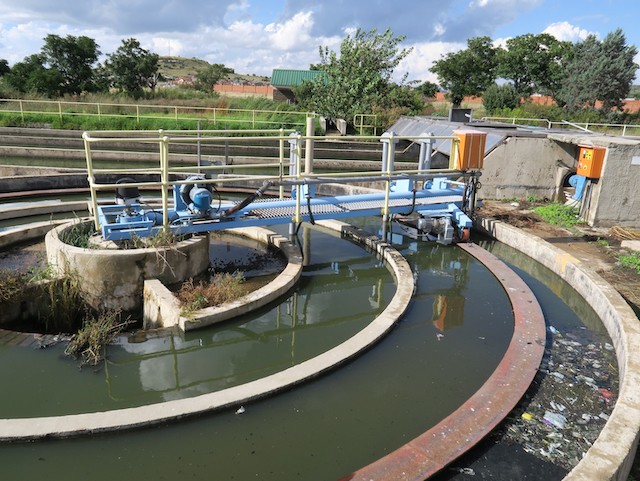
The dilapidated wastewater treatment plant in Winburg.
Data from the IRIS site also shows the wastewater treatment works are, in the words of the DWS’s Green Drop report, in a “critical state”, which means they “need urgent intervention for all aspects of the wastewater services business”.
There are three quality indicators for the effluent released from the sewage works into the environment: microbiological compliance, indicating the concentration of faecal bacteria, such as E.coli and enterococcus, in the water; chemical compliance, indicating the concentration of chemicals such as nitrates and phosphates which negatively impact ecosystems; and physical compliance, indicating turbidity (the clearness of the water), electrical conductivity and oxygen demand. The minimum compliance levels are set out in the wastewater treatment works’ authorisation issued by the DWS.
The Winburg wastewater treatment works, as of 18 June, scored zero for all three indicators. This is indicates that the municipality has not achieved the basic requirement of providing regular test results to the regulator.
A contractor who spoke on condition of anonymity said he oversaw upgrades to the sewage pump stations and refurbishment of the wastewater treatment works in 2020. As part of the contract the company installed a generator to ensure the works continued to function during load shedding. But he said after they completed the work, which included fixing the aerators essential to purifying the sewage, “some genius” in the municipality decided to move the generator to another facility. But the electrical lines ran through the generator so without it, there was no power at all at the wastewater treatment works. Rewiring it was a simple job for any qualified electrician, yet this was never done.
He said the company also advised the municipality that it needed to replace the town’s sewerage pipes, which were old asbestos pipes which were continually breaking. “They were breaking in people’s yards,” he said.
All effluent from the wastewater treatment works, as well as sewage from broken sewerage lines and pump stations flowed to the dam from which drinking water was drawn, but even if the water purifying plant at the dam was working properly, it wasn’t designed to clean water contaminated by sewage, he said.
Documents circulated in the municipal council meeting of June shows a consultant, a civil engineering firm, and an electrical and mechanical contractor were appointed to refurbish Winburg’s water purification plant in January 2019. “However, due to poor performance, both the contractor and consultant were terminated,” states the document.
A new consultant was appointed in August 2021, along with the same electrical and mechanical contractor, with a R25.6-million refurbishment budget. The document states the water purification plant was in a “dilapidated state”.
The plant required refurbishment of its mechanical works, electrical works, and piping. It also required civil work on its exterior, such as landscaping, surfacing of the road, roof works, and brick works.
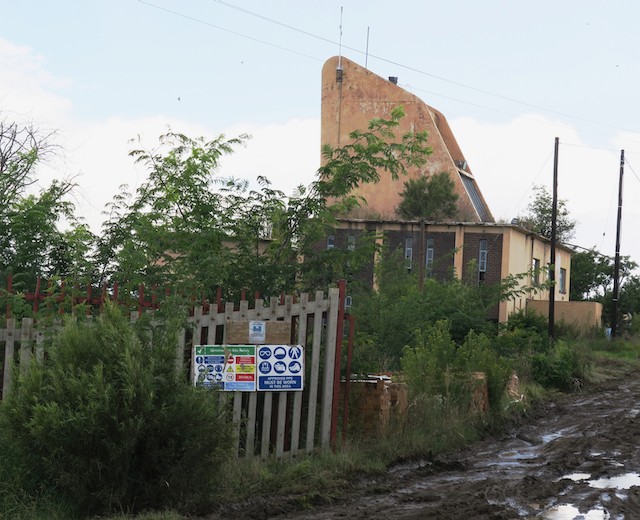
The water treatment plant in Winburg, which purifies water for drinking, has shrubs and grass growing from its gutters and cracks in the walls despite a refurbishment contract worth R25-million awarded in August last year.
When GroundUp visited the site in March, it was clear no such exterior work had been done.
Brunhilde Rossouw, a councillor for Masilonyana local municipality, said the consultant and contractor arrived on site in August 2021 “but very, very little” work took place, with no work having been done since October. She said the contract with the consulting engineering firm had been stopped “due to illegal appointment”.
“We hear no more than that and they are also waiting for payment,” she said.
The council document states that the DWS had not paid invoices since August 2021, causing “huge delays” on the project. The contractors were not paid from September 2021 to February 2022.
Winburg falls within the Masilonyana local municipality, which includes the towns of Theunissen, Verkeerdevlei and Brandfort, the town where Winnie Mandela was banished for eight years by the apartheid government.
While Winburg’s failure to provide clean drinking water is striking in that the supply dam is polluted with untreated effluent from the wastewater treatment works, it is not unique. Drinking water supply fails to meet minimum standards throughout the Masilonyana local municipality. Data on the IRIS dashboard for June shows the drinking water in all four towns is contaminated by faecal bacteria, measured as microbiological compliance.
Verkeerdevlei had 0% for microbiological compliance, while Theunissen achieved 29%, Winburg 56%, and Brandfort 89%. The minimum standard for compliance is 97%.
Similarly, wastewater treatment works in all these towns are failing. All have failed to report effluent quality from their wastewater treatment works for over two years. These data are also reflected on an interactive map.
While Brandfort, although failing, performs best in terms of drinking water quality within the Masilonyana local municipality, supply is intermittent. Brandfort residents keep containers at hand and fill them up whenever there is water in the taps, as they do not know when water will come out their taps again. It can be days.
In Winburg, much of the town fetches clean drinking water from the NG church borehole on Mondays, Wednesdays, and Fridays.
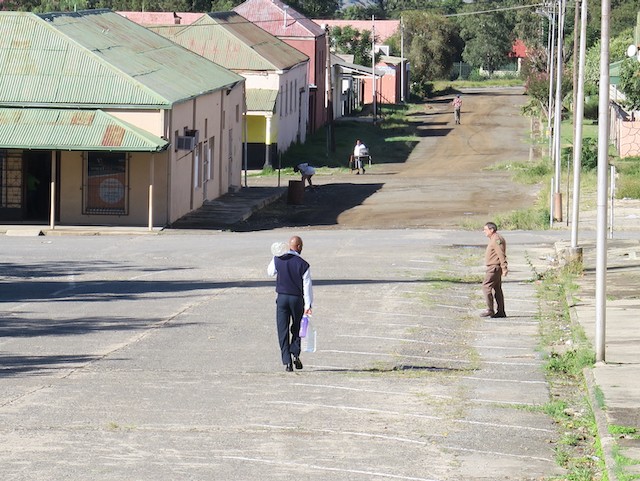
Winburg residents, including those working for the municipality, walk home with containers of fresh water collected from the NG church borehole.
Free State water woes
The Masilonyana local municipality is just one of 19 municipalities in the Free State. As of June, only three municipalities in the province had drinking water which met minimum microbiological and chemical compliance standards. These were Tswelopele local municipality (Bultfontein and Hoopstad), Metsimaholo local municipality (Sasolburg, Deneysville, and Oranjeville) and Phumelela (Memel, Vrede, Warden).
Effluent data from June shows no municipal wastewater treatment plants met the minimum effluent standards set by the DWS. There is only one plant in the province that performs to standard, and it is operated by Sasol.
The Green Drop report of 2022, published on 1 April and covering the period July 2020 to June 2021, states 64 of 96 sewage treatment works in the Free State are in a critical state, achieving a score of 31% or less.
Of the 19 municipalities, 17 (including Masilonyana) were placed under regulatory focus for wastewater and given 60 days from the date of publication of the report to submit a detailed corrective action plan. The plan must map the activities, responsible persons, timelines, and expected improvements. The deadline would have been 31 May. Asked whether any corrective action plans had been received, the DWS failed to respond despite follow up calls.
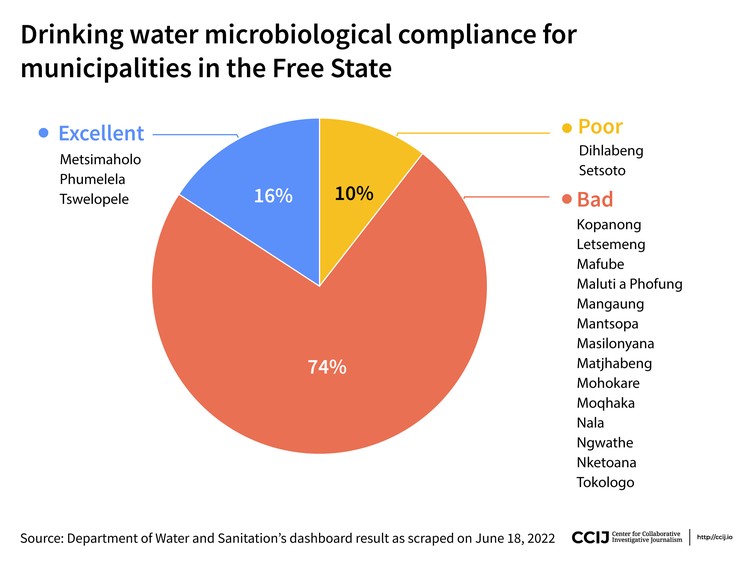
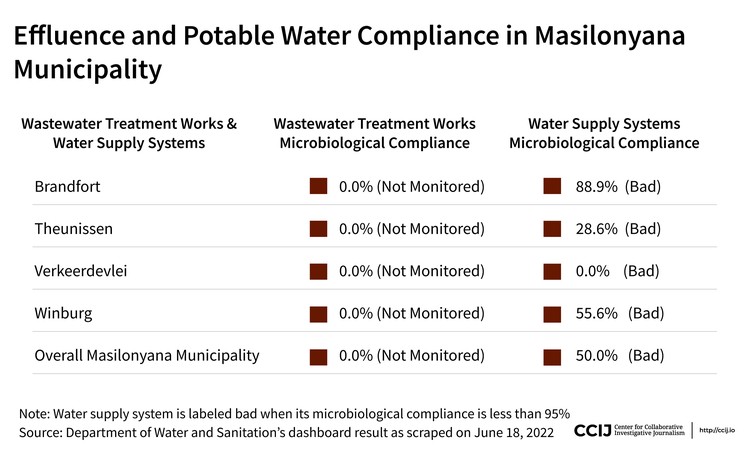
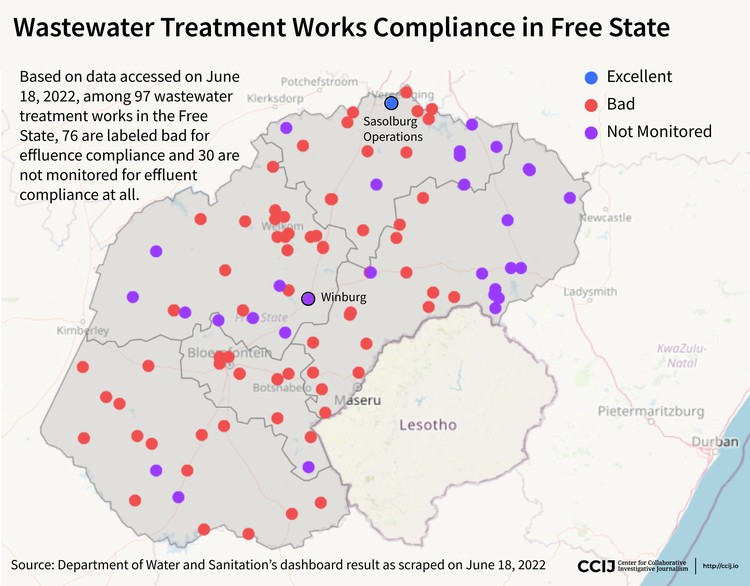
© 2022 GroundUp. This article is licensed under a Creative Commons Attribution-NoDerivatives 4.0 International License.
You may republish this article, so long as you credit the authors and GroundUp, and do not change the text. Please include a link back to the original article.
We put an invisible pixel in the article so that we can count traffic to republishers. All analytics tools are solely on our servers. We do not give our logs to any third party. Logs are deleted after two weeks. We do not use any IP address identifying information except to count regional traffic. We are solely interested in counting hits, not tracking users. If you republish, please do not delete the invisible pixel.
[ad_2]
Originally Appeared Here